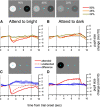Attention to bright surfaces enhances the pupillary light reflex
- PMID: 23365255
- PMCID: PMC6619119
- DOI: 10.1523/JNEUROSCI.3440-12.2013
Attention to bright surfaces enhances the pupillary light reflex
Abstract
One longstanding question is how early in the visual system attention exerts its influence. Here we show that an effect of attention can be measured at the earliest possible stage of visual information processing, as a change in the optics of the eye. We tested human subjects and found that covertly attending to bright surfaces results in an enhanced pupillary light reflex (PLR)-the pupillary constriction that occurs in response to light increments. The PLR optimizes the optical quality of the retinal image across illumination conditions, increasing sensitivity by modulating retinal illumination, and improving acuity by reducing spherical aberrations. The attentional modulation of the PLR that we describe constitutes a new mechanism through which vision is affected by attention; we discuss three alternatives for the neural substrates of this effect, including the possibility that attention might act indirectly, via its well established effects in early visual cortex.
Figures




References
-
- Aston-Jones G, Cohen JD. An integrative theory of locus coeruleus-norepinephrine function: adaptive gain and optimal performance. Annu Rev Neurosci. 2005;28:403–450. - PubMed
-
- Barbur J. Learning from the pupil: studies of basic mechanisms and clinical applications. In: Chalupa L, Werner J, editors. The visual neurosciences. Cambridge: MIT; 2004. pp. 641–656.
-
- Brainard DH. The psychophysics toolbox. Spat Vis. 1997;10:433–436. - PubMed
-
- Campbell FW, Gregory AH. Effect of size of pupil on visual acuity. Nature. 1960;187:1121–1123. - PubMed
Publication types
MeSH terms
LinkOut - more resources
Full Text Sources
Other Literature Sources
